
Chandrayaan-3
- 8 minsThe Chandrayaan-3 is the third daring lunar exploration mission after Chandrayaan-1 (2008) and Chandrayaan-2 (2019) conducted by the Indian Space Research Organization (ISRO).
It will be a highly complex mission that will demonstrate ISRO’s capability of safe and soft landing on the lunar surface and rover mobility; and is expected to further India’s scientific exploration of the moon.
Why is the Moon so Important?
The Moon is our closest neighbor in the vast expanse of space. It has existed long before the very beginning of mankind and was seen as a mystical object in the skies of our ancestors. But fast-forward to the 21st century, how much exactly do we know about our neighbour?
Studying the Moon provides us with a way to understand the Solar System’s early history. Few models can explain the creation of the moon. Variations in the lunar surface studied by mapping its surface was key in understanding the origin and evolution of the moon.
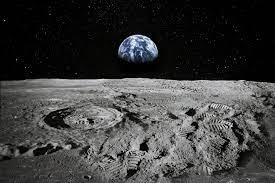
In 2008, the Chandrayaan-1 Orbiter made an important and exciting discovery from its mass spectra readings.
The evidence of water on the moon!
Further studies were required by carefully examining the lunar surface to re-affirm this finding.
The Lunar South pole is especially interesting because of the lunar surface area that remains in shadow is much larger than that at the North Pole. There could be a possibility of presence of water in permanently shadowed areas around it.
Introduction
Chandrayaan-3 is a follow-on mission to the partially successful Chandrayaan-2, which saw the perfect insertion of the Orbiter into Lunar Polar Orbit, but failed at landing the Vikram lander on the lunar surface. The goal of Chandrayaan-3 is similar to its predecessor’s, which is to demonstrate end-to-end capability in safe landing and rover maneuvering on the lunar surface.
What happened to Chandrayaan-2?
Chandrayaan-2 set out to confirm the presence of water near the Lunar South Pole. This type of mission would be the first for ISRO as a soft landing and rover maneuvering operation on another stellar body had never been carried out before by the organization in the past.
The designed space craft consisted of an Orbiter, Lander (named Vikram Lander) and a Rover (named Pragyaan Rover).
Mission Aftermath
By 1st September 2019, Chandrayaan-2 entered a circular Lunar Polar Oribt, which meant the mission was set for the next phase, which was the most complex part of the entire mission; Soft landing on the lunar surface. Vikram began its descent on 6 September 2019 and was to be performed by the on-board computers on Vikram, with mission control unable to make corrections.
It was observed that the lander’s trajectory began to deviate at about 2.1km from the surface. Final telemtry readings from the lander displayed that the final vertical velocity was 58m/s at 330m above the surface, which was too fast for landing.
Then ISRO Chairman, Dr. K. Sivan stated that “it must have been a hard landing”, which indicated that the lander had crashed on the lunar surface. Both ISRO and NASA attempted to communicate with the lander, but got no response from the lander.
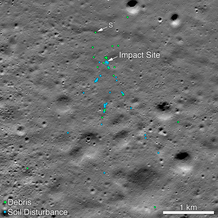
Vikram’s impact site was later located at 70.8810°S 22.7840°E by the LROC team after receiving helpful input from Shanmuga Subramanian, a volunteer from Chennai, Tamil Nadu. The spacecraft shattered upon impact, with debris scattered in an area spanning kilometres. It was concluded that the crash was due to a software glitch.
Chandrayaan-3
Mission Objectives
The mission objectives of Chandrayaan-3 are:
- Demonstrate Safe and Soft Landing on Lunar Surface.
- Demonstrate Rover mobility on Moon’s surface.
- Conduct in-situ scientific experiments.
Design
The Chandrayaan-3 mission module will consist of:
- Lander Module (LM) : Demonstrate soft landing capability and Rover deployment
- Propulsion Module (PM) : Carry Lander Module till Lunar polar orbit (100km) and deploy LM
- Rover : Demonstrate rover maneuverability on Lunar surface and carry out in-situ chemical analysis
The launcher identified for Chandrayaan-3 is GSLV-Mark 3 which will place the integrated module in an Elliptic Parking Orbit. The PM will remain in orbit around the Moon and act as a communications relay satellite.
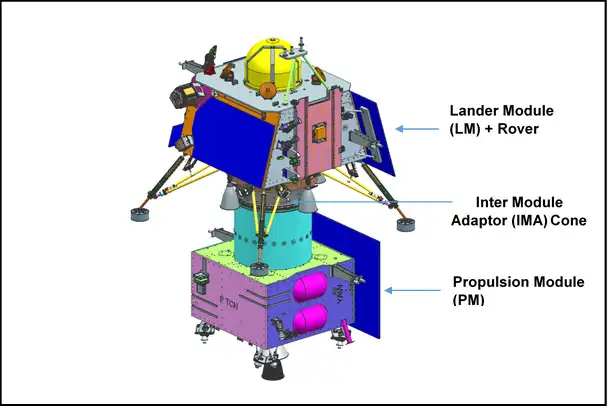
The Mass and Power specifications of the modules are listed below.
| Mass (kg) | Power (W) | |
|---|---|---|
| Propulsion Module | 2148 | 758 |
| Lander Module | 1752 | 738 |
| Rover | 26 | 50 |
| Total | 3900 | 1546 |
The Lander houses 4 Reaction wheels for attitude control, each capable of generating 10Nms of Angular momentum and 0.1Nm of Torque.
The Lander’s Bi-Propellant Propulsion System uses a mixture of MMH (Monomethylhydrazine) and MON3 (Mixed Oxides of Nitrogen with 3% Nitric Oxide) and consists of:
- 4x 800N Throttleable Engines
- 8x 68N Throttleable Engines
A vast array of sensors are also present on the Lander. They are listed under.
- Laser Inertial Referencing and Accelerometer Package (LIRAP)
- Ka-Band Altimeter (KaRA)
- Lander Position Detection Camera (LPDC)
- LHDAC (Lander Hazard Detection & Avoidance Camera)
- Laser Altimeter (LASA)
- Laser Doppler Velocimeter (LDV)
- Lander Horizontal Velocity Camera (LHVC)
- Micro Star sensor
- Inclinometer & Touchdown sensors
Lander
The Scientific payloads carried onboard the Lander are:
| Payload | Abbreviation | Description |
|---|---|---|
| Radio Anatomy of Moon Bound Hypersensitive ionosphere and Atmosphere | RAMBHA | To measure near surface plasma density and its changes with time |
| Chanda’s Surface Thermo-physical Experiment | ChaSTE | Carry out measurements of thermal properties of lunar surface near polar region |
| Instrument for Lunar Seismic Activity | ILSA | Measure seismicity around the landing site and delineating the structure of lunar crust and mantle |
| Laser Retroreflector Array | LRA | Understand the dynamics of the moon |
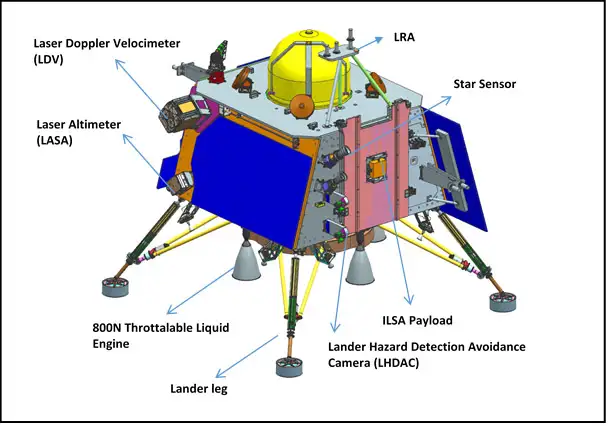
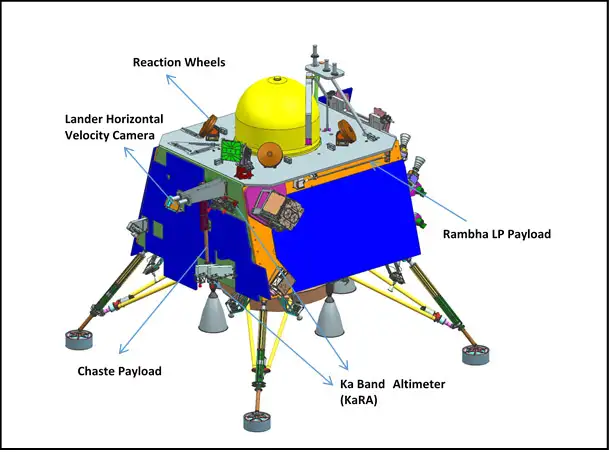
Rover
The Scientific payloads carried onboard the Rover are:
| Payload | Abbreviation | Description |
|---|---|---|
| Alpha Particle X-Ray Spectrometer | APXS | To determine the elemental composition of Lunar soil and rocks around the lunar landing site |
| Laser Induced Breakdown Spectroscope | LIBS | Qualitative and quantitative elemental analysis & To derive the chemical Composition and infer mineralogical composition |
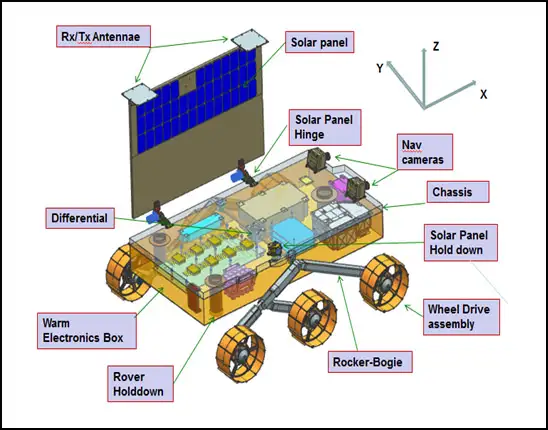
Propulsion Module
The Scientific payloads onboard the PM are:
| Payload | Abbreviation | Description |
|---|---|---|
| Spectro-polarimetry of HAbitable Planet Earth | SHAPE | Determine quality of habitability of future exo-planets found based on reflected light |
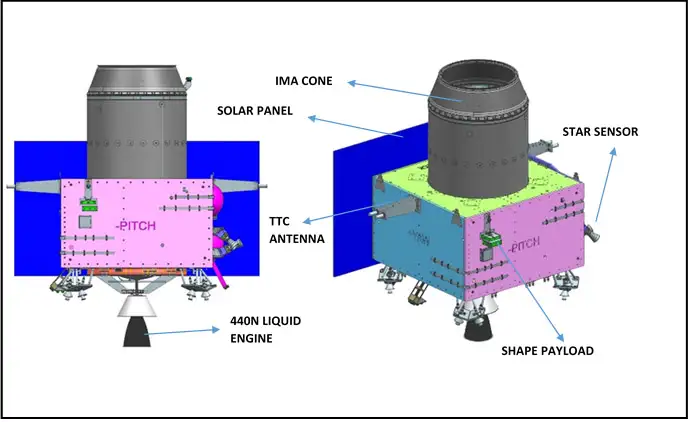
Mission Profile
The mission is currently scheduled to launch on 14 July 2023 at 9:05 UTC (2:35 p.m. IST), with a possibility to launch as late as 19 July, from Satish Dhawan Space Center in Sriharikota, India. The PM will bring the lander/rover will into a 100 km circular polar lunar orbit and separate.
The lander will then touch down with the rover in the south polar region of the Moon, near 69.37 S, 32.35 E. The lander and rover are designed to operate for one lunar daylight period (about 14 Earth days).
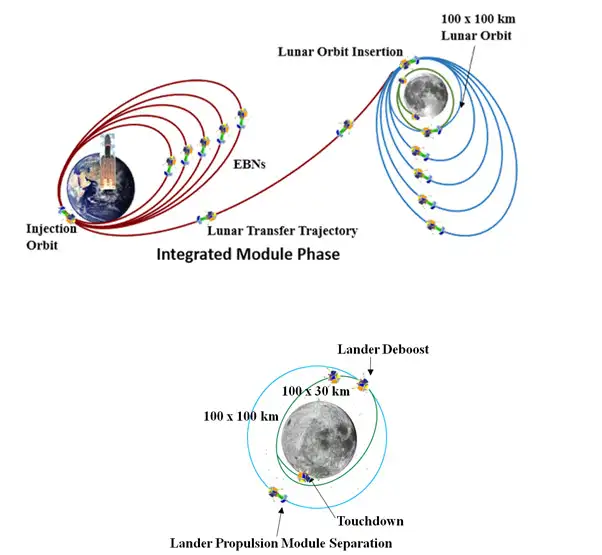
What makes Chandrayaan-3 different from before?
Having understood and learnt from the mistakes of Chandrayaan-2, Chandrayaan-3 improved its design to ensure a successful landing this time.
It incorporates the following:
-
Simplified Payload
The Chandrayaan-3 will be equipped with a lander and a rover only. The PM will be utilised for communication and terrain mapping requirements during the mission.
-
Improved Lander Module
Chandrayaan-3 will feature two “lander hazard detection & avoidance cameras” to assist in coordination with the orbiter and mission control as compared to the single camera on its predecessor.
Conclusion
The outcome of the Chandrayaan-3 mission will be a major milestone in the story of India’s Space Program. Success of the mission would mean unravelling a vast portion about our cosmic past and will also pave way for future bold expeditions.
The ingenuity of the Scientists and Engineers who are a part of this mission, coupled with the hopes and prayers of a billion proud Indians will take this mission to great heights and mark an important day in history.